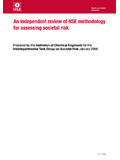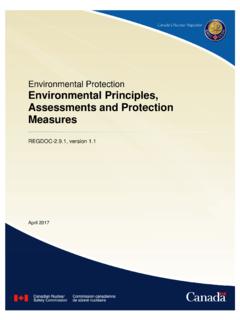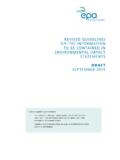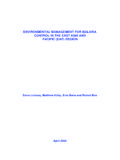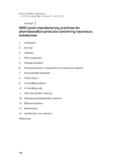Transcription of Health and Safety Executive The SACGM …
1 Heading/title Health and Safety Executive The SACGM compendium of guidance Part 3: Containment and control of activities involving genetically modified microorganisms HSE Books Table of contents Containment and control of activities involving genetically modified microorganisms ..5. Overview .. 5. Using the guidance .. 6. Biosecurity .. 8. Organisational control .. 8. Containment and control measures for laboratory activities involving genetically modified microorganisms ..9. Overview .. 9. Scope .. 9. Selecting the minimum containment level .. 10. Definitions .. 11. Containment measures for laboratory activities involving GMMs (Schedule 8 Table 1a) .. 13. Laboratory Containment Level 1 .. 15. 15. System of work .. 16. Waste .. 17. Other 17. Laboratory Containment Level 2 .. 18. 18. System of work .. 19. Waste .. 20. Other 20. Laboratory Containment Level 3 .. 22. 22. System of work .. 24. Waste .. 25. Other 25. Laboratory Containment Level 4.
2 27. 27. System of work .. 28. Waste .. 29. Other 30. Containment and control measures for large-scale activities involving genetically modified microorganisms ..31. Overview .. 31. Scope .. 32. Selecting the minimum containment level .. 32. Definitions .. 34. Containment measures for large-scale activities involving GMMs .. 37. Large-scale Containment Level 1 .. 39. General .. 39. 40. System of work .. 40. Large-scale Containment Level 2 .. 42. General .. 42. 43. System of work .. 44. Large-scale Containment Level 3 .. 46. 2. General .. 46. 47. System of work .. 48. Large-scale Containment Level 4 .. 51. General .. 51. 52. System of work .. 53. Containment and control measures for activities with GMMs that involves handling animals ..55. Overview .. 55. Scope .. 55. Definitions .. 57. Animal welfare legislation .. 57. Containment measures for activities with animals involving GMMs .. 59. Containment Level 1 for GMMs in an animal facility.
3 60. Other measures (see Laboratory Containment Level 1) .. 61. Containment Level 2 for GMMs in an animal facility .. 63. Other measures (see Laboratory Containment Level 2) .. 64. Containment Level 3 for GMMs in an animal facility .. 66. Other measures (see Laboratory Containment Level .. 3) .. 67. Containment Level 4 for GMMs in an animal facility .. 69. Other measures (see Laboratory Containment Level .. 4) .. 71. Inactivation ..72. Overview .. 72. Definitions .. 72. Physical inactivation methods .. 73. Chemical inactivation 74. Overview .. 78. Fumigation of rooms .. 78. Emergency room 79. Fumigation of microbiological Safety 80. Validation of 81. Fumigants and fumigation 81. Microbiological Safety cabinets ..85. Overview .. 85. Choosing the correct equipment .. 85. Installation .. 88. Factors affecting MSC performance .. 89. In use' operator protection factor testing .. 90. Maintenance .. 90. Training .. 91. Containment and control measures for work with DNA encoding oncogenic Overview.
4 92. Naked DNA: possible hazards and routes of transmission .. 92. Control measures .. 93. 3. Further 4. Containment and control of activities involving genetically modified microorganisms Overview 1. The Genetically Modified Organisms (Contained Use) Regulations require that all activities involving genetically modified microorganisms (GMMs) in containment must use physical, chemical or biological barriers or any combination of these to limit contact with people and the environment. They also demand that certain standards of occupational and environmental Safety be met. The following sections of guidance set out in broad terms the requirements of the Contained Use Regulations for the handling of GMMs in different situations. Plant growth facilities are not covered in this section and users are directed to Part 4 for guidance relevant to activities with GMMs associated with plants. 2. The guidance is divided into several sections and users will have to determine which guidance is relevant to the activity being undertaken and conform to the regulatory requirements covered by that guidance: Containment and control measures for laboratory activities involving GMMs is intended to give guidance to help users determine the appropriate standards of containment and control that should be applied to work involving GMMs in laboratories, or small-scale activities.
5 Containment and control measures for large-scale activities involving GMMs is intended to give guidance to help users determine the appropriate standards of containment and control that should be applied to work involving GMMs at a large- scale, for example a biomanufacturing plant. Containment and control measures for activities with GMMs that involves handling animals is intended to give guidance to help users determine the appropriate standards of containment and control that should be applied to animal studies involving GMMs. Users are directed to Part 5 for considerations relating to the risk assessment, containment and control of work involving GM or transgenic animals. 3. There is also more specific guidance relating to: Inactivation. Fumigation. Microbiological Safety cabinets. Handling of oncogenic sequences. 5. Using the guidance 4. Any reference to regulations in the following guidance refers to the Contained Use Regulations.
6 5. The level of containment and control is required to be commensurate with, and determined by, the risk assessment. Regulation 18 requires that users compare the measures warranted by the risk assessment with the appropriate table of containment measures set out in Schedule 8. This determines the GM activity class, which in turn determines the minimum containment level needed for that activity and notification requirements. 6. The relevant Schedule 8 table is reproduced in each section. Control measures at every containment level has appropriate guidance associated with it. This guidance is intended to offer advice with respect to how to achieve the appropriate standards. Some of the listed control measures will not be required at the lower containment levels and, in some cases, the guidance will simply reflect this. The guidance may, however, also highlight other measures that are considered good practice or approaches that can be implemented to achieve the standards required by the legislation.
7 These approaches are illustrative and users may adopt other methods so long as the standards set by the legislation are met. 7. The Schedule 8 tables describe containment for the use of GMMs in laboratories, animal houses and other' settings (which is interpreted as large-scale industrial research and production facilities). There are some settings for which these tables are not particularly appropriate, for example, a clinic. Users in such settings must execute containment and control, although it is acknowledged that application and interpretation of the Schedule 8. tables may be difficult and users in these situations should contact HSE for further guidance. Specific guidance for the use of GM organisms in a clinical setting can be found in Part 6. 8. This mechanism for determining the containment measures is underpinned by the requirements of regulation 17. This requires that exposure of humans and the environment, and the level of harm to humans as a result of activities involving genetically modified organisms, be reduced to the lowest level that is reasonably practicable.
8 In addition to the containment measures set out in Schedule 8, the principles of good microbiological practice and good occupational Safety and hygiene must be applied, to the extent to which they are appropriate. These principles are detailed in Schedule 7 of the regulations and are reproduced below. Additional guidance on each of these measures can be found in the HSE publication A guide to the Genetically Modified Organisms 6. (Contained Use) Regulations 2000 L29 (Third edition) HSE Books 2000 ISBN 978 0 7176. 1758 6. Keeping workplace and environmental exposure to any genetically modified micro- organism to the lowest reasonably practicable level. Exercising engineering control measures at source and supplementing these with appropriate personal protective clothing and equipment where necessary. Testing adequately and maintaining control measures and equipment. Testing, where necessary, for the presence of viable process organisms outside the primary physical containment.
9 Providing appropriate training of personnel. Formulating and implementing local codes of practice for the Safety of personnel, as required. Displaying biohazard signs where appropriate. Providing washing and decontamination facilities for personnel. Keeping adequate records. Prohibiting in the work area eating, drinking, smoking, applying cosmetics or the storing of food for human consumption. Prohibiting mouth pipetting. Providing written standard operating procedures where appropriate to ensure Safety . Having effective disinfectants and specified disinfection procedures available in case of spillage of genetically modified microorganisms. Providing safe storage for contaminated laboratory equipment and materials where appropriate. 9. The general requirements of regulation 17 and the application of the general principles of good microbiological practice (GMP) and of good occupational Safety and hygiene (GOSH) from Schedule 7 are required for all activities in any setting.
10 For example, activities involving self-cloned organisms are exempt from all the Contained Use Regulations, except for regulation 17. 10. It is important that users consider measures other than those set out in the tables, or those listed above. Some control measures deemed necessary by the risk assessment may not be specifically mentioned. For example, the use of sealed centrifuge rotor buckets or respiratory protective equipment might be required in certain circumstances to protect the user against aerosols. Furthermore, the measures required at each containment level may not provide appropriate protection for the environment. The risk assessment should be used to identify particular elements of containment that are lacking and the measures implemented accordingly to afford maximum protection for human Health and the environment. 7. All measures shown to be necessary by the risk assessment must be implemented, but only those in the table will affect the GM activity classification and notification requirements.









